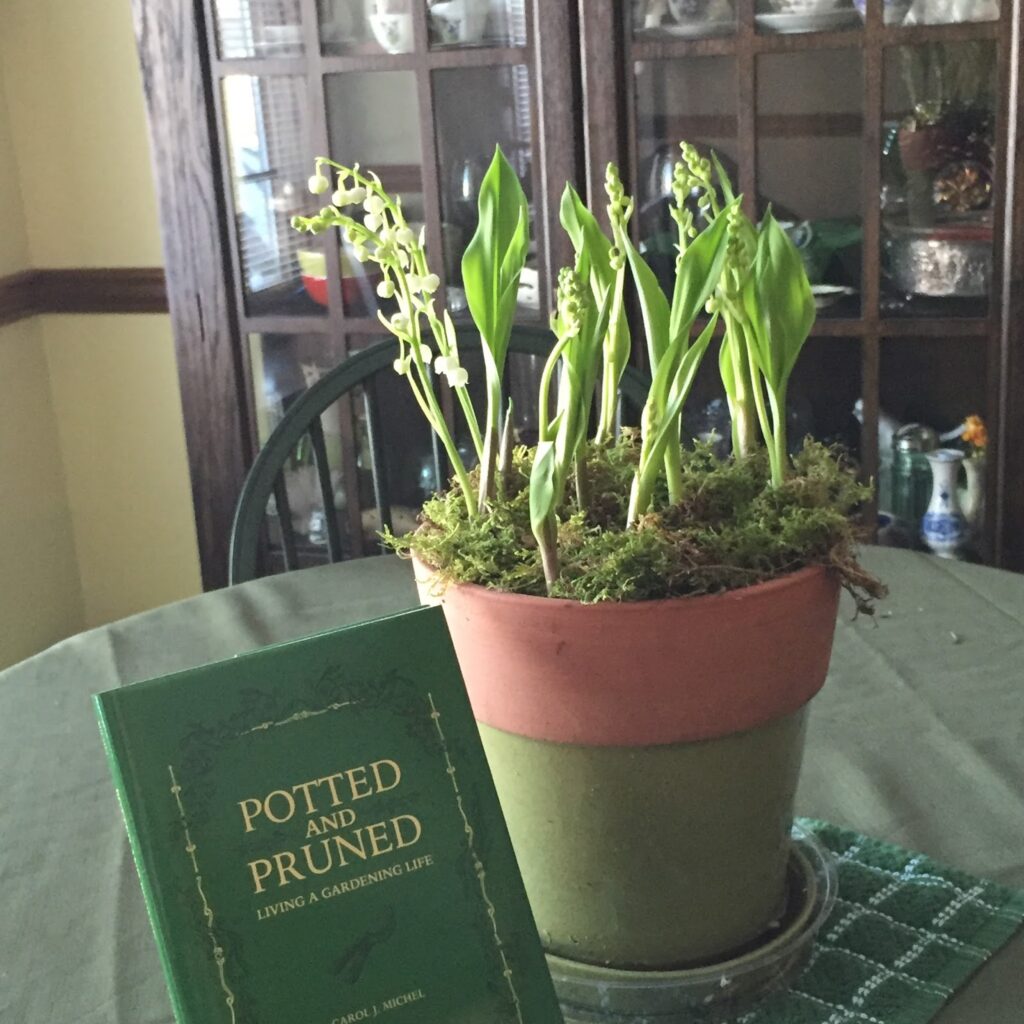
Let’s force some Lily of the Valley into bloom like it’s 1897.
That’s the year Lizzie Page Hillhouse, one of the Lost Ladies of Garden Writing, wrote her book, House Plants and How to Succeed With Them. She included a chapter with instructions on how to force Lily of the Valley into bloom.
She starts off with the botaical name, Convallaria majalis. Order Liliaceæ.
Fortunately, the taxonimists have, so far, left the botanical name alone but they did decide to move it to another family. It’s now in the Asparagaceae family. Thankfully, no one has yet suggested we change the common name as a result of this move.
Lizzie next tell us, “These hardy herbaceous perennials make lovely window boxes for early spring; indeed, with but little trouble you can have them at any time you wish.”
With but little trouble? At any time you wish? I wish to have them at Christmastime, or shortly thereafter.
Here’s how she says to do that:
“Plant Lilies of the Valley thickly in shallow boxes during the fall as suggested for Daisies and Pansies; cover them lightly with straw, leaves, or salt hay; and leave them outside until you want them in the house. When you bring these plants in, put them away in some perfectly dark and very warm place, keeping them moist with warmed water.“
I’m now trying to think where in my house to put a pot of lily of the valley where it will be perfectly dark and very warm? Hmmm. Under a box somewhere? Yes, I think under a box for awhile.
The next step…
“If kept dark and warm enough they presently will begin to grow. As soon as they commence to shoot up leaves and show flower stalks, they must be moved to a window, where they will not get too much sun; and be well supplied with water.”
A window where they won’t get too much sun sounds like either a north or east window, especially in the winter time. I like the idea of them “commencing.”
Next she reveals a secret!
“The secret of success is to keep them very cold until you are ready to use them; then the change to sudden heat forces them into activity.”
I fully intend to dig up a few lily of the valley pips this week, clean them off, and put them in the back of the refrigerator where they will be very cold until I’m ready to pot them up.
More tips from Lizzie…
“The most satisfactory results I have ever seen from forcing Convallarias, were obtained by taking the bunches of pips without untying, just as they come from abroad—the imported ones being best for this purpose—laying them on the ground outside in the fall; and simply throwing a little salt hay over them as winter advances, to keep the crowns from freezing.”
All well and good to read that now. Many of us who have purchased and forced Lily of the Valley into bloom in the winter are quite aware that the one source we used to rely on for lily of the valley pips for forcing stopped selling them. They said they could no longer get pre-cooled pips in time to ship before Christmas. I did a little checking online to see if anyone else has any Lily of the Valley pips for sale right now, in late November, and came up empty-handed.
But I do have Lily of the Valley in my garden, ready to dig up!
Lizzie repeats her instructions:
“They were taken in as needed; kept in a warm room for a while, to thaw out; then planted in pots or boxes of sand, or sphagnum moss. They were now given plenty of heat; and, when brought to the light, were never allowed to want for water; shaded from the sun; and supplied with sufficient air, but guarded from cold draughts.“
Never allowed to want for water. In modern words, don’t let them dry out. Put them where they get some air but not cold air. I think that’s pretty much any place in a house except right by the front door. Unless you live where it’s warm all the time, then anyplace is fine.
Lizzie also says you can force Lily of the Valley into bloom anytime of the year, provided you keep some pips chilled for that purpose.
“In summer some gardeners keep the pips in cold storage, taking them out as required; they are thus enabled whenever they please to have the Lilies in bloom. Florists, by means of cold storage, are in these advanced days upsetting a great many of Dame Nature’s calculations, forcing her from the beaten track, and breaking all her established rules. As to whether the result is an improvement upon her methods, we must leave the decision to those who demand a constant change from the old routine.”
Where in 1897 did they have cold storage, especially in the summer? Ice houses? I’ll admit, I did look up “history of refrigerators” and discovered there was a lot going on with inventions for refrigerators in the 1800s but most were for commerical purposes. The first home model was invented around 1913.
And from what she wrote, I’m not sure Lizzie liked the idea that florists are forcing Lily of the Valley into bloom anytime they want to. I suppose seeing Lily of the Valley in bloom in September might look weird, but I’ve seen enough vintage Christmas postcards featuring Lily of the Valley flowers to know it wasn’t an odd thing to find blooming indoors around the holidays, especially after refrigerators became available.
So that’s exactly what I plan to do. Force some Lily of the Valley into bloom in the middle of winter, 1897 style. (Well, sort of 1897 style. I plan to chill my pips in a refrigerator.)
(An aside! Lily of the Valley was reported to be Queen Elizabeth II’s favorite flower. They were included in her wedding bouquet and in the flowers she carried for her coronation. More recently, I saw reports that some bouquets from her funeral in September also included Lily of the Valley, no doubt forced into bloom by some florist somewhere.)



Leave a Reply